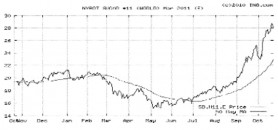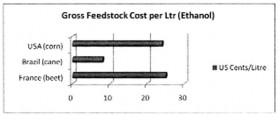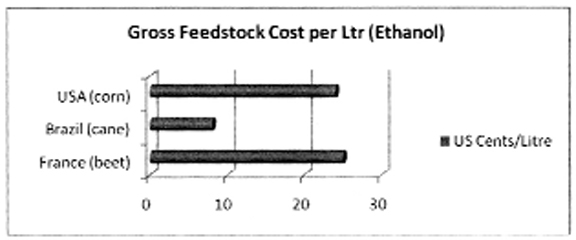Dear Editor,
On October 15, 2010, the FT stated that raw sugar prices are set to test a 30 year high of 28 cents a pound (US$627 per ton) since Brazil and India are unlikely to satisfy growth in demand over the next 12 months. The general consensus in London is that a surge to 30 cents is highly possible. (See graph below on world sugar prices and where it is trending)
 Guyana is currently getting about US$465 per ton from the EU. This provides a stable price and a guaranteed market for 185,000 tons and thus predictability for the industry. In this current global economic environment this is a tangible asset for any country, thus all the crocodile tears about the EU dropping prices is a grand effort to hide the inefficiency of the leadership within the industry. What value is Gita Knight or Raj Singh adding to the board? Does GuySuCo have a professional cost accountant in its team? At the end of the day, the Board of Directors at GuySuCo are President Jagdeo’s ambassadors and if they do poorly, he too is responsible; it is his board. It was President Jagdeo who said that Gita Knight had “significant skills.” What significant skills?
Guyana is currently getting about US$465 per ton from the EU. This provides a stable price and a guaranteed market for 185,000 tons and thus predictability for the industry. In this current global economic environment this is a tangible asset for any country, thus all the crocodile tears about the EU dropping prices is a grand effort to hide the inefficiency of the leadership within the industry. What value is Gita Knight or Raj Singh adding to the board? Does GuySuCo have a professional cost accountant in its team? At the end of the day, the Board of Directors at GuySuCo are President Jagdeo’s ambassadors and if they do poorly, he too is responsible; it is his board. It was President Jagdeo who said that Gita Knight had “significant skills.” What significant skills?
Once the world price falls below 21 cents, we are in the money in an advantageous manner (this happened between February and September 2010) and even if it goes above that price, we have a guaranteed market for 185,000 tons. The strategy for Guyana then should be singularly focused on making the production of sugar cheaper than 21 cents a pound and in amounts more than 300,000 tons.
That is why we developed the Guyana Sugar Action Plan – to mitigate the challenges in the sugar belt. We were supposed to build new ethanol distilleries with private capital to diversify the revenue streams from comparative advantageous feed stock. We were supposed to have a new and more efficient sugar factory (long-term sugar refinery) at Skeldon, with state resources, to reduce our cost of producing sugar. We were to review our agronomic practices in the field and slowly but surely commence the conversion of the fields to accommodate motorized cane-harvesters. Let me make it clear, none of these strategies have come to fruition according to the timeline outline in the Sugar Action Plan.
Thus it is not difficult to comprehend why we are where we are today. My answer is political cronyism and a mis-focused and very distracted regime.
President Jagdeo markets a certain US$30 million from Norway as if it is ‘manna’ for the economic redemption of Guyana. Value added industrialization linked to our agricultural core is the long-term sustainable solution for Guyana and as per norm our President is dead wrong. Again!
Sugar is intertwined with the sweat and blood of thousands of our peoples’ lives, regardless of race, religion or gender.
There is a high collateral value associated with sugar and thus the government should not have treated this industry in such a cavalier and off-hand manner. These issues have been there for years and no one was listening to Komal Chand, among significant others. I am convinced that GAWU is an authority on the solutions for the sugar belt. A non-partisan board of directors including a trained sugar technologist, trained agronomist, trained engineers and trained cost accountants (please note, I said cost – CIMA) should be given the mandate to review everything done by the current board of directors. The boards of DDL are a good starting point for new recruits, and there is no better person than Yesu Persaud to lead the revival of this industry and yes, that same Errol Hanoman who left GuySuCo. But the crux of this letter is, why is ethanol good for Guyana and why do I have great doubts about the seriousness of President Jagdeo when he was reported in the SN article of June 20, 2010 as saying that “Government is looking seriously at ethanol from molasses projects”? There seems to be a lot of confusion surrounding the production and trade in ethanol in OP. This is hardly surprising recognizing there was limited executive time for anything else but the LCDS. Thus too little effort was made by the regime in understanding the economic benefits of ethanol for Guyana. This has meant very little policy action on this vital developmental issue. At least the AFC is on the forefront of this issue with their leadership having a great understanding of the E-10 concept, leading to its adoption in their 2011 manifesto/blueprint. Fuel ethanol is not the same as alcoholic ethanol, and more than 95% of the fuel ethanol produced globally is from agriculture stocks. As the graph shows below, cane sugar is the cheapest source of ethanol production and thus we have an in-built comparative advantage compared to the beet and corn producers. We must note that the gross feedstock cost does not take into account the additional revenue streams from the sale of agro-energy to the national grid.
 There are two basic types of fuel ethanol, anhydrous (99% pure and free of water) and hydrous (96% pure). The anhydrous is used for the E-10 blending with gasoline, while the hydrous is used as a 100% substitute for gasoline on cars with dedicated engines. Guyana can easily produce the anhydrous ethanol for blending (new investments, new jobs). We have the land (Canje Basin, second depth), we have interested investors with key vested interest (Brazil and India), and we have the market (USA through the Caribbean Basin Initiative). What we don’t have is the political leadership to see this through to the end as they continue to ‘cuss’ the World Bank for other people’s money. We have a distracted political leadership who are more interested in satisfying their financiers and failing to develop the ethanol industry at the expense of a working people – workers in the sugar belt.
There are two basic types of fuel ethanol, anhydrous (99% pure and free of water) and hydrous (96% pure). The anhydrous is used for the E-10 blending with gasoline, while the hydrous is used as a 100% substitute for gasoline on cars with dedicated engines. Guyana can easily produce the anhydrous ethanol for blending (new investments, new jobs). We have the land (Canje Basin, second depth), we have interested investors with key vested interest (Brazil and India), and we have the market (USA through the Caribbean Basin Initiative). What we don’t have is the political leadership to see this through to the end as they continue to ‘cuss’ the World Bank for other people’s money. We have a distracted political leadership who are more interested in satisfying their financiers and failing to develop the ethanol industry at the expense of a working people – workers in the sugar belt.
The world has seen an explosion in the fuel ethanol market which has tripled from less than 20 billion to over 73 billion litres per annum from 2000 to 2009, and is expected to hit 85 billion litres per annum in 2010. In 2009 the International Energy Agency called the build-out of bio-fuels production a necessary component of meeting our future energy needs. As a result of this many countries are working seriously to secure their future energy needs by expanding their alternative energy production facilities, but only in Guyana ‘goat bite we.” A sensible ethanol strategy translates into a reduction of our oil imports, more jobs and more money for developmental projects.
The technology has improved so much that the efficiency of the production process has reduced the cost of production over the years. What would the policymakers do with this information? That is up to them. I know what the AFC is doing with it, good things.
Yours faithfully,
Sasenarine Singh

